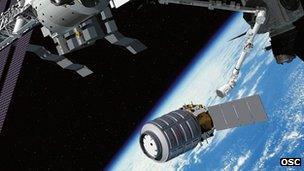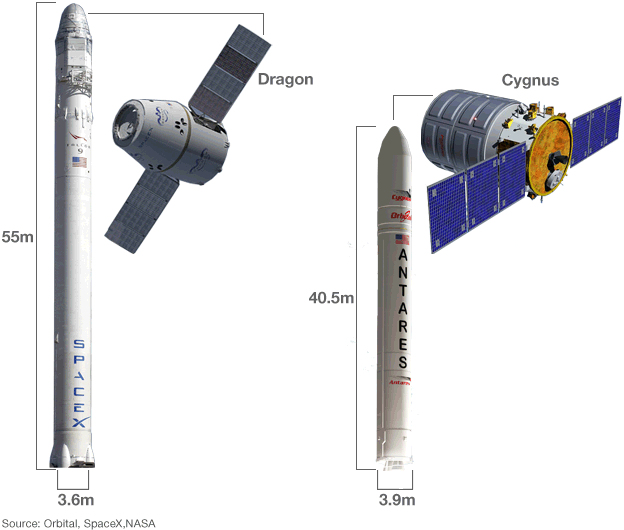Orbital's Cygnus space freighter embarks on maiden voyage
- Published

Antares flies from Nasa's Wallops Flight Facility in eastern Virginia
The new Cygnus commercial cargo ship has launched on a demonstration voyage to the International Space Station.
Built by Orbital Sciences Corporation (OSC), the robotic vessel lifted off atop an Antares rocket from the Wallops spaceport in Virginia, US.
Cygnus is one of two private systems seeded by Nasa to meet America's ISS re-supply requirements following the retirement of the space shuttles.
A successful mission will see OSC begin a series of operational cargo flights.
Nasa has awarded the company a $1.9bn (£1.2bn) contract covering eight sorties to the station.
Lift-off occurred at 10:58 local time (14:58 GMT).
The two-stage Antares appeared to work flawlessly. Its aim was to put the freighter in an orbit more than 240km above the Earth.

The station's robotic arm will reach out and grab the parked Cygnus freighter
Cygnus will have to use its own thrusters over the course of the next four days to raise its altitude and chase down the space station.
Because this is a demonstration mission, Nasa has insisted on a number of practice manoeuvres to ensure the ship poses no danger when it approaches the ISS.
Assuming all goes well, Cygnus will park itself just under the orbiting lab on Sunday.
The astronauts onboard the platform will then reach out with a robotic arm and grab the freighter, berthing it to a free port.
The job of unloading the roughly 700kg (1,500lb) of food and equipment will begin on Monday.
The expectation is that Cygnus will stay at the ISS for about a month.
Before departure, the ship will be filled with station waste.
It will take this rubbish into a destructive dive in the atmosphere over the Southern Pacific Ocean.
The cargo module will manoeuvre autonomously once close to the ISS. Video by the BBC's Matt Danzico
Nasa is attempting to hand over routine human spaceflight operations in low-Earth orbit to commercial industry, in a way similar to how some large organisations contract out their IT or payroll.
The carriage of freight is the first service to be bought in from external suppliers; the transport of astronauts to and from the station will be the second, later this decade.
The US space agency hopes these changes will save it money that can then be invested in exploration missions far beyond Earth, at destinations such as asteroids and Mars.
To this end, it offered Orbital a series of incentive payments to help it develop a cargo-delivery system, with the carrot of a bumper operational contract once it was working.
So far, OSC has met 28 of 29 milestones in the development of Cygnus and Antares, earning $285.5m in the process. Satisfactory completion of the demonstration mission will tick a 29th milestone, releasing a final $2.5m payment. But, more importantly, it would also then green-light the first fully commercial run to the space station in December.
Although $288m is a sizeable sum, it did not match what the company itself had put up, said OSC vice president Frank Culbertson.
"The Orbital investment far exceeds the Nasa investment, so we're hoping for a long series of cargo re-supply missions to help recoup that," he told reporters in a pre-launch briefing.
Italian heritage
Nasa has also seeded California's SpaceX company in the development of its Falcon 9 rocket and Dragon capsule.
This system is already in operation, with two missions completed in a 12-flight, $1.6bn contract.
Having a choice of companies is important to Nasa.
Alan Lindenmoyer, who manages the agency's Commercial Crew and Cargo Program, said: "You never want to be put in a situation where, if there's a problem with one of the suppliers, you don't have the ability to continue with your re-supply chain to the space station.
"That's why we intentionally designed our programme to have at least two companies, certainly in the development and demonstration phase. And then we were fortunate enough to award contracts to both [SpaceX and Orbital]."
Cygnus has significant European involvement. The pressurised vessel that holds the cargo is produced in Turin, Italy, by Thales Alenia Space (TAS).
Its design is based on the logistics modules that TAS produced for the space shuttles when the orbiters ran cargo deliveries to the station.

-
Dragon capsule
Length: 5.2m
Diameter: 3.6m
Upmass: 6t
The capsule is re-usable
-
Cygnus capsule
Length: 6.7m
Diameter: 3m
Upmass: 2.7t
Cygnus is destroyed on re-entry
-
Falcon 9 launch vehicle
Design: Two stages
Mass: 334t
Thrust at lift-off: 5,000kN
Fuel: Liquid oxygen/kerosene
-
Antares launch vehicle
Design: Two stages
Mass: 240t
Thrust at lift-off: 3,000kN
Fuel: Liquid oxygen/kerosene
Jonathan.Amos-INTERNET@bbc.co.uk and follow me on Twitter: @BBCAmos, external
- Published21 April 2013
- Published10 January 2013
- Published8 October 2012
- Published10 April 2012